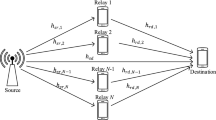Abstract
Performance of conventional cooperative communication networks using amplify-and-forward relay over independent and identically distributed Rayleigh fading channels is investigated in this paper. An expression for probability density function by using moment generating function is obtained. Further closed-form expressions of the outage probability and the average channel capacity are derived. The derived analytical results are compared with Monte Carlo simulations to confirm correctness of the derived expressions.



Similar content being viewed by others
References
Abramowitz, M., & Stegun, I. (1972). Handbook of mathematical functions with formulas, graphs, and mathematical tables. New York: Dover.
Anghel, P. A., & Kaveh, M. (2004). Exact symbol error probability of a cooperative network in a Rayleigh-fading environment. IEEE Transactions on Wireless Communications, 3(5), 1416–1421.
Beaulieu, N. C., & Hu, J. (2006). A closed-form expression for the outage probability of decode-and-forward relaying in dissimilar Rayleigh fading channels. IEEE Communications Letters, 10(12), 813–815.
Brennan, D. (1959). Linear diversity combining techniques. Proceedings of the IRE, 47(6), 1075–1102.
Dixit, D., & Sahu, P. (2012). Symbol error rate of rectangular QAM with best-relay selection in cooperative systems over Rayleigh fading channels. IEEE Communications Letters, 16(4), 466–469.
Gao, Y., Ge, J., & Cong, W. (2013). Differential quadrature amplitude modulation and relay selection with detect-and-forward cooperative relaying. Wireless Personal Communications, 72(2), 1399–1414.
Gradshteyn, I. S., & Ryzhik, I. M. (2007). Table of integrals, series, and products (7th ed.). SanDiego: Academic Press.
Gunther, C. (1996). Comment on “Estimate of channel capacity in Rayleigh fading environment”. IEEE Transactions on Vehicular Technology, 45(2), 401–403.
Ikki, S. S., & Ahmed, M. H. (2009). Exact error probability and channel capacity of the best-relay cooperative-diversity networks. IEEE Signal Processing Letters, 16(12), 1051–1054.
Ikki, S. S., & Ahmed, M. H. (2011). Performance analysis of cooperative diversity with incremental-best-relay technique over Rayleigh fading channels. IEEE Transactions on Communications, 59(8), 2152–2161.
Kuhn, V. (2006). Wireless communications over MIMO channels: applications to CDMA and multiple antenna systems. West Sussex: John Wiley.
Kumar, N., & Bhatia, V. (2015). Performance analysis of amplify-and-forward cooperative networks with best-relay selection over Weibull fading channels. Wireless Personal Communications, 85(3), 641–653.
Laneman, J. N., Tse, D. N., & Wornell, G. W. (2004). Cooperative diversity in wireless networks: Efficient protocols and outage behavior. IEEE Transactions on Information Theory, 50(12), 3062–3080.
Ouyang, J., Lin, M., & Zhuang, Y. (2012). Performance analysis of cooperative relay networks over asymmetric fading channels. Electronics Letters, 48(21), 1370–1371.
Samb, D., & Yu, L. (2013). Performance analysis of amplify and forward cooperative relaying protocol in wireless communication system. Wireless Personal Communications, 70(2), 969–983.
Shrestha, S., & Chang, K. (2010). Closed-form solution of outage capacity for cooperative DF and AF relay network. Wireless Personal Communications, 54(4), 651–665.
Simon, M. K., & Alouini, M. S. (2005). Digital communication over fading channels (2nd ed.). New York: Wiley.
Torabi, M., Ajib, W., & Haccoun, D. (2009). Performance analysis of amplify-and-forward cooperative networks with relay selection over Rayleigh fading channels. In IEEE 69th vehicular technology conference, 2009. VTC Spring 2009 (pp. 1–5).
Zhao, Y., Adve, R., & Lim, T.J. (2006). Improving amplify-and-forward relay networks: Optimal power allocation versus selection. In IEEE international symposium on information theory 2006 (pp. 1234–1238).
Acknowledgments
The authors would like to thank anonymous reviewers for their invaluable comments and IIT Indore for research facilities.
Author information
Authors and Affiliations
Corresponding author
Rights and permissions
About this article
Cite this article
Kumar, N., Bhatia, V. Outage Probability and Average Channel Capacity of Amplify-and-Forward in Conventional Cooperative Communication Networks over Rayleigh Fading Channels. Wireless Pers Commun 88, 943–951 (2016). https://doi.org/10.1007/s11277-016-3221-0
Published:
Issue Date:
DOI: https://doi.org/10.1007/s11277-016-3221-0




